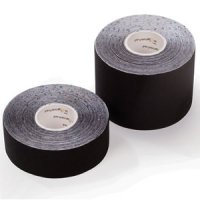In the realm of sports medicine and physical therapy, a remarkable tool has emerged that has caught the attention of athletes, healthcare professionals, and individuals seeking pain relief and improved performance. Enter kinesiology tape, a thin and stretchy adhesive tape that has gained popularity for its unique properties and therapeutic benefits. Join us as we delve into the world of kinesiology tape, uncovering its purpose, applications, and potential to support your body’s needs.
What is Kinesiology Tape?
Kinesiology tape, also known as kinesio tape or elastic therapeutic tape, is a specialized tape made from cotton fibers with an activated acrylic adhesive. Developed in the 1970s by Dr. Kenzo Kase, a Japanese chiropractor, this tape was designed to mimic the elasticity and thickness of human skin. Unlike traditional athletic tape, kinesiology tape offers a stretchy, flexible nature that supports movement without restricting it.
The Science Behind Kinesiology Tape
The k-tape has a unique composition and elasticity provide several potential benefits. By gently lifting the skin, kinesiology tape may enhance blood and lymphatic circulation, reducing swelling and promoting the removal of waste products. It is also believed to stimulate mechanoreceptors, improving proprioception and enhancing the body’s awareness of movement and positioning.
Applications of Kinesiology Tape
Explore the diverse range of applications for sport tape. Athletes often use it to provide support to muscles and joints, potentially reducing the risk of injury during training and competition. Additionally, kinesiology tape has found a place in the treatment of various conditions, including sprains, strains, tendonitis, postural issues, and musculoskeletal discomfort.
How Does Kinesiology Tape Work?
From pain modulation and joint stabilization to enhanced muscle function and improved postural alignment, explore the theories surrounding kinesiology tape’s impact on the body. While scientific evidence is still emerging, anecdotal reports and preliminary research suggest its potential benefits.
Proper Application Techniques
From understanding the direction and tension of the tape to preparing the skin and ensuring a secure bond, precise application techniques are essential for optimal results. This section will guide you through step-by-step instructions and provide tips for maximizing the tape’s effectiveness.
Seeking Professional Advice
While kinesiology tape can be easily purchased and applied by individuals, it is crucial to consult with a healthcare professional, such as a physical therapist or sports medicine specialist, for a comprehensive evaluation and guidance tailored to your specific needs. They can provide expertise in determining the most appropriate taping techniques, duration of use, and integration with other treatment modalities.
How to Use Kinesiology Tape
Proper application is key to maximizing the benefits of kinesiology tape. Follow these general guidelines to ensure effective usage:
1. Prepare the Skin
Start by ensuring the skin is clean, dry, and free from oils, lotions, or hair. Shave any areas with excessive hair growth to promote better tape adhesion.
2. Measure and Cut
Measure the desired length of tape, keeping in mind the specific area you intend to target. Cut the tape with rounded corners to prevent premature peeling or fraying.
3. Apply with Proper Tension
Gently stretch the tape to the desired tension, usually around 10-20% stretch, and apply it directly to the skin. Avoid overstretching, as it may cause discomfort or skin irritation.
4. Rub and Activate the Adhesive
Once applied, firmly rub the tape to activate the adhesive and enhance its bond with the skin. This friction-generated heat helps the tape adhere better.
5. Avoid Wrinkles and Bubbles
Smooth out the tape as you apply it, avoiding wrinkles or bubbles that could compromise its effectiveness. Ensure a snug fit while maintaining comfort and ease of movement. Some areas are harder to apply the tape than others, for example, kt tape for ankles is far harder to apply than kt tape for shoulders.
6. Follow Specific Techniques
Depending on the purpose of sport tape, different techniques can be utilized. These techniques may involve supporting muscles, stabilizing joints, correcting posture, or alleviating pain. Seek guidance from a healthcare professional or refer to reliable sources for specific taping techniques for different body parts and conditions.
7. Duration of Wear
The duration of kt tape wear can vary based on the individual, the condition being treated, and the intended purpose. Generally, kinesiology tape can be worn for several days, even while showering or engaging in light physical activity. However, it’s essential to monitor your skin for any signs of irritation or discomfort. If irritation occurs, remove the tape promptly.
8. Proper Removal
To remove the tape, gently peel it off in the direction of hair growth while supporting the skin. Taking a warm shower or using an adhesive remover can help ease the removal process.
Remember, while these guidelines offer a general framework for using physio tape, it is crucial to consult with a healthcare professional for personalized instructions and guidance tailored to your specific needs.
Use in Professional Sports
Kinesiology tape has captured the attention of athletes and individuals seeking alternative methods for pain relief, injury prevention, and performance enhancement.
It can be used as knee support tape or shoulder support tape. While the scientific evidence supporting its effectiveness continues to evolve, many people have experienced positive outcomes. By understanding the purpose, applications, and proper techniques of muscle tape, you can make informed decisions about its potential role in supporting your body’s needs. Embrace this innovative tool as part of your journey towards improved physical well-being, always prioritizing consultation with healthcare professionals for personalized guidance and care.
Disclaimer: This article is for informational purposes only and does not constitute medical advice. Always consult with a qualified healthcare professional before using kinesiology tape or starting any new treatment.


